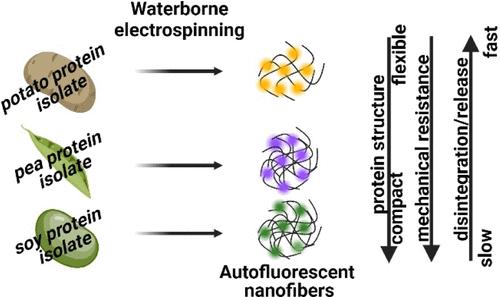当前位置:
X-MOL 学术
›
ACS Sustain. Chem. Eng.
›
论文详情
Our official English website, www.x-mol.net, welcomes your feedback! (Note: you will need to create a separate account there.)
Eco-Friendly Electrospun Nanofibers Based on Plant Proteins as Tunable and Sustainable Biomaterials
ACS Sustainable Chemistry & Engineering ( IF 7.1 ) Pub Date : 2024-06-25 , DOI: 10.1021/acssuschemeng.4c00895 Kleopatra Kalouta 1, 2 , Mai Bay Stie 2, 3 , Xuedan Sun 2 , Vito Foderà 2, 3 , Valeria Vetri 4
ACS Sustainable Chemistry & Engineering ( IF 7.1 ) Pub Date : 2024-06-25 , DOI: 10.1021/acssuschemeng.4c00895 Kleopatra Kalouta 1, 2 , Mai Bay Stie 2, 3 , Xuedan Sun 2 , Vito Foderà 2, 3 , Valeria Vetri 4
Affiliation

|
Plant protein-based nanofibers generated by eco-friendly waterborne electrospinning are emerging as sustainable and innovative materials with vast applications in different biomedical areas. In this study, we fabricated electrospun nanofibers based on potato, pea, and soy protein isolates, achieving remarkably high protein content without the use of organic solvents, strong bases, or surfactants. The different protein nanofibers were characterized by means of quantitative fluorescence imaging, optical spectroscopy, and dynamic mechanical analysis. Results indicated that the intrinsic nature of the proteins modulated the properties of the nanofibers in terms of morphology, fluorescence fingerprints, mechanical strength, and stability in aqueous environments. Pea and soy protein isolates, both rich in β-structure, led to the formation of robust and dense nanofibers, which slowly disintegrated in water. On the contrary, less dense and highly soluble nanofibers were generated from the structurally more flexible potato protein isolate, and these nanofibers demonstrated lower resistance to breakage. Our findings indicate the importance of protein structural elements when designing protein-based electrospun nanofibers with specific features. Deciphering the intricate relationship between protein structure at the molecular level and properties of nanofiber holds promise for the development of biomaterials with enhanced efficacy in diverse biomedical applications.
中文翻译:

基于植物蛋白的环保电纺纳米纤维作为可调节和可持续的生物材料
通过环保水性静电纺丝产生的植物蛋白纳米纤维正在成为可持续的创新材料,在不同的生物医学领域有着广泛的应用。在这项研究中,我们基于马铃薯、豌豆和大豆分离蛋白制造了电纺纳米纤维,在不使用有机溶剂、强碱或表面活性剂的情况下实现了非常高的蛋白质含量。通过定量荧光成像、光谱学和动态力学分析对不同的蛋白质纳米纤维进行了表征。结果表明,蛋白质的内在性质调节了纳米纤维在形态、荧光指纹、机械强度和水环境稳定性方面的特性。豌豆和大豆分离蛋白均富含β结构,可形成坚固而致密的纳米纤维,并在水中缓慢分解。相反,结构上更灵活的马铃薯分离蛋白产生了密度较小且高度可溶的纳米纤维,并且这些纳米纤维表现出较低的抗断裂性。我们的研究结果表明,在设计具有特定功能的基于蛋白质的电纺纳米纤维时,蛋白质结构元素的重要性。破译分子水平上的蛋白质结构与纳米纤维特性之间的复杂关系有望开发出在多种生物医学应用中具有增强功效的生物材料。
更新日期:2024-06-25
中文翻译:

基于植物蛋白的环保电纺纳米纤维作为可调节和可持续的生物材料
通过环保水性静电纺丝产生的植物蛋白纳米纤维正在成为可持续的创新材料,在不同的生物医学领域有着广泛的应用。在这项研究中,我们基于马铃薯、豌豆和大豆分离蛋白制造了电纺纳米纤维,在不使用有机溶剂、强碱或表面活性剂的情况下实现了非常高的蛋白质含量。通过定量荧光成像、光谱学和动态力学分析对不同的蛋白质纳米纤维进行了表征。结果表明,蛋白质的内在性质调节了纳米纤维在形态、荧光指纹、机械强度和水环境稳定性方面的特性。豌豆和大豆分离蛋白均富含β结构,可形成坚固而致密的纳米纤维,并在水中缓慢分解。相反,结构上更灵活的马铃薯分离蛋白产生了密度较小且高度可溶的纳米纤维,并且这些纳米纤维表现出较低的抗断裂性。我们的研究结果表明,在设计具有特定功能的基于蛋白质的电纺纳米纤维时,蛋白质结构元素的重要性。破译分子水平上的蛋白质结构与纳米纤维特性之间的复杂关系有望开发出在多种生物医学应用中具有增强功效的生物材料。











































 京公网安备 11010802027423号
京公网安备 11010802027423号